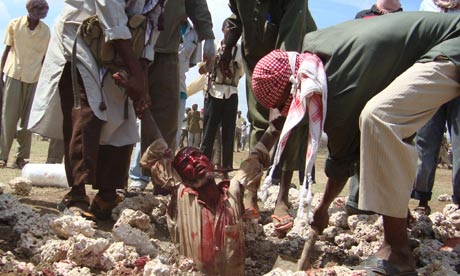When reading this artical http://www.guardian.co.uk/artanddesign/2010/mar/08/world-press-photo-sean-ohagan about images of a man stoned to death in december of 2010. I was very shocked that these were taken, however i do know what stuff like this still happened within some parts of the world.

After some thinking these are what i think of such images being taken: I believe images like this should be show to the world. As I feel that many of us are born, especially in first world counties, with wool over our eyes. We all live very comfortably and many of us not knowing much of the world outside our country and how lucky we really are. Taking pictures of tragic events is a way of showing the true world that we are living in. These photographers are a witness of those events and they should be shared in order for human beings to reflect more deeply onto the world, plus themselves and I think help shake the world out of their indifference. Photography brings forward issues and educate people who do not wish to listen to words. However when looking at these images it is shocking,it almost makes you not want to look or know about why this man has had this done to him because of guilt you were not there to stop it. Yet I feel it is disrespectful towards the stoned man to offer no captions or text explaining why this has happened to him.
"I have been a witness,and these pictures are my testimony. The events I have recorded should not be forgotten and must not be repeated." – quote from James Nachtwey a documentary photographer of war and suffering
If people are more interested about war photography, how its done, why some feel the need to do it and what kind of person it takes. You should look at the documentary War Photographer. It can be found on YouTube and its really insightful. Focusing on James Nachtwey and the stress of dealing with viewing the worst of the world as a job.
Instagram is an application for smartphones that has recently just been bought by Facebook for $1billion. For anyone who doesn't know the application, it allows the user to take a picture with their phone then add coloured filters and borders to it, to create a 'vintage' effect. You can then upload your photographs taken with the app on to the social network facebook, where friends can see and share with each other. The debate about Instagram is very heated. Many people turn their noses up at it, saying that it is not a true form of photography and laugh at those who class themselves as photographers that use it. While others simple see it as a fast and easy way to share and capture moments with each other, having fun with the many filters that make the pictures more appealing.
I am personally annoyed with seeing pictures taken on Instagram filling my facebook newfeed of mundane objects and scenes, blue skies, light poles, bus stations, coffee cups, office chairs and even paving stones, suddenly are classed as cool and amazing with a old rusty filter place on top of the image. Often the effect doesn't match the subject, a brand new pair fluffy slippers in bad lighting with a dusty scratched old 50s tint effect placed on top? really?
Yet I'm not saying that I think Instagram is a bad thing, as I have seen some very good photographs with good compersions and lighting. However I feel that many people look down upon Instagram simple because normally the bad photographs out weigh the good. Yet it quick and easy giving many people who don't have time or unable to understand film photography a chance to still show their artistic flare, which might have become lost without this app. But it often annoys people who send long amounts of time developing film and working really hard to get an effect, while suddenly instagram can do it in seconds.
Overall I think Instagram is good, if used by people who already understand image composition and lighting. Its very simpler to how digital photography and photoshop are looked down upon, but are slowly being accepted as a art form.

